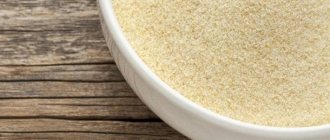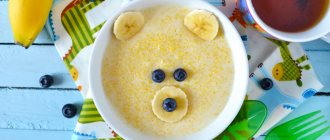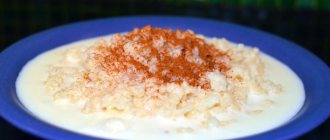Gluten-containing porridges are porridges made from oats, rye, semolina, wheat, barley and pearl barley. It is recommended to introduce gluten porridges at a later date due to more difficult digestion and the possibility of allergic reactions.
According to statistics, about 1 in 100 people suffer from latent, atypical and true forms of celiac disease in Finland, and 1 in 300 people in Italy (pasta country!). Today, of this number, for every 1 case of obvious classical manifestation of celiac disease, there are 6 hidden manifestations, which also cause harm to health.
Symptoms of Gluten Allergy
Please note: symptoms of allergies or hypersensitivity to gluten may only become noticeable 3-8 weeks after the first entry of the gliadin protein (gluten) into the child’s intestines.
Symptoms of gluten intolerance are:
- intestinal disorders (stools are copious, fatty, with a grayish tint, with foam, foul-smelling, diarrhea/constipation, flatulence, abdominal pain);
- delay in the rate of physical development (growth indicators and especially weight are inhibited);
- disorders of the nervous system (the child becomes moody, restless, sleeps poorly);
- problems with skin, nails and hair appear; sometimes dermatitis can be the only manifestation of gluten intolerance.
Review of porridge manufacturers
"Baby." There are 3 types of dairy-free and dairy oatmeal, several types of wheat porridge with fruit, and a selection of multigrain porridges with interesting berry additives. All 5 varieties of porridge “For afternoon snacks” contain wheat cookies, which classifies them as gluten-containing. Berries and milk are added to the “For Afternoon Snacks” porridges; they are classified as desserts and have an incredibly delicate milky aroma, which will really appeal to kids with a refined taste. The cookies in these cereals are 20% (in some 10%), they contain traces of soy or soy lecithin.
"BelLact" . It is practiced mainly on gluten-free porridges, so the assortment is small - 2 oat and 1 wheat dairy-free porridges, from dairy - oatmeal with the addition of rice / corn and porridge from 5 grains, which contains oats and wheat, and there is also a very rare dairy millet porridge.
"Vinnie" . Dairy-free options include oatmeal, wheat and 7-grain porridge with additives, which contains rye and millet in addition to wheat and oats. Dairy products include oatmeal, wheat and pumpkin, and multigrain porridge, which contains 3 gluten-containing grains.
"Karapuz" . The majority of cereals are gluten-free. The porridges have a rare, varied composition: in addition to the usual ingredients, porridges made from several grains contain rye, millet, and barley.
"Nestlé" . Basically, all milk porridges that the manufacturer recommends after 6–8 months, including Pomogaiki and Shagaiki, are gluten-containing. There is a wide choice of porridge, a variety of additives, the main thing is to look at the composition and avoid consuming substances to which the child is allergic, because the front of the box does not always reflect the full composition of the filling. For example: 5-grain porridge with strawberries and cherries also contains orange, apple, pear, passion fruit and beet juice. There are also porridges containing a flavoring identical to natural (vanillin). Among dairy-free porridges, “Pomogaiki” is made from several grains; they contain gluten, and some have vanillin added. These porridges contain flour from millet, sorghum and other grains, which means that these porridges are well suited for introducing all varieties of grains. They also have a line of 10 “Bistrov” oatmeal porridges - made only from healthy and natural products.
"Nordic" . In its pure form it provides oatmeal, millet, semolina, wheat, and rye porridge. There are several types of instant oatmeal. Some cereals contain salt, sugar and vanilla.
"Nutrilon" . Has 3 milk wheat porridges and the same number of multigrain cereals.
"Samper" . The only manufacturer that has both wheat and semolina porridges. The composition of wheat porridge states that it is made from partially hydrolyzed wheat groats, while that of semolina porridge is made from partially hydrolyzed semolina. What is the difference? We hope that natural minerals and vitamins are preserved.
"Frutonyanya" . There are 3 oat and wheat porridges, and these cereals are also available in the form of ready-made liquid porridges.
"Heinz" . There is a variety of oat milk porridges; among the delicacies there are wheat porridges. Contains prebiotic chicory fiber.
We did not indicate other well-known manufacturers, since the list of their products includes only 2-3 porridges made from oats or wheat.
How and when to start complementary feeding?
It is recommended to start complementary feeding for infants with gluten-free porridges. If the baby is fed with mother's milk, offering him a cereal dish for the first time is acceptable at 6 months. Earlier introduction is undesirable, because the intestines of a child in the first six months of life are not yet mature enough to digest anything other than mother’s milk.
Formula-fed babies can try porridge a little earlier. Although baby food packages are sometimes marked “from 4 months,” doctors advise introducing porridge into the diet of formula-fed toddlers no earlier than 5 months of age.
Most often, rice or buckwheat is chosen for the first acquaintance. If your baby often has constipation, it is better to prefer buckwheat, and in case of loose stools, rice porridge is included first on the menu. A dish for an infant should be single-component and dairy-free, the consistency should be liquid and homogeneous, and not contain sugar, salt or any other additives.
Some mothers decide to prepare such porridge themselves, grinding the cereal in a coffee grinder so that it turns into flour, after which it is boiled in water, and then breast milk or formula is added. Other parents choose factory-made porridge for the first feeding, since selected raw materials are used for such baby food products, which are specially processed. In addition, there is no need to cook powdered porridge - it is enough to dilute it with water in the amount specified by the manufacturer, and the dish for the baby in the required volume is ready.
After introducing rice and buckwheat into the diet, the baby is introduced to corn porridge. Because it is more difficult to digest, millet is recommended to be given to children over one year old. Milk porridge is given to a breastfed baby no earlier than 9 months of age, and to an artificial baby - from 7 months. The introduction of milk porridge into the diet also begins with gluten-free options, that is, buckwheat, corn porridge or rice are prepared first with milk.
Semolina and wheat porridge, what is the difference?
Both semolina and wheat porridge are made from the same grain - wheat. But it should be noted that wheat porridge has a richer composition - more vitamins of group B, PP, iron and phosphorus. How much richer is, of course, the question. Wheat cereal is made from durum wheat and unrefined grains. For obvious reasons, baby food manufacturers mostly sell wheat porridge rather than semolina. And semolina is poorer, because it is made from grains of higher purification and is distinguished by finer grinding. On the shelves of our stores, semolina made from soft and hard-soft wheat varieties is more often found.
Which porridge to choose for the first feeding
At what age should cereals be introduced?
Young mothers are interested in which porridges are the healthiest for first feeding. The issue of age directly depends on the method of feeding the baby. Artificial babies are recommended to start complementary feeding from the age of four months. Breastfed babies are ready to eat solid food when they can sit confidently and hold a spoon independently.
Experts are unanimous in their opinion that the first feeding of cereals should begin no later than six months of age.
Getting started with porridge
What is complementary feeding? This word refers to any food other than breast milk and formula. Complementary feeding begins with foods such as
- juices and decoctions;
- boiled egg yolk;
- vegetable and fruit purees;
- cottage cheese.
When the baby’s digestive system has adapted to the assimilation and digestion of these products, you can begin to get acquainted with cereals.
Experts recommend introducing dairy-free, gluten-free baby cereals into your baby’s diet first, and then you can switch to milk porridges containing gluten:
- oatmeal;
- semolina;
- wheat
Why shouldn’t you delay the start of your first acquaintance with cereals? Because after the age of six months it is more difficult to teach a child to chew. Timely introduction of solid food is perceived naturally by the baby, while delaying this process provokes a negative perception of food and the inability of the gastrointestinal tract to digest and assimilate foods.
Signs your baby is ready to eat cereal
The development of a child's body occurs individually. If one baby is ready to eat cereal by the age of four months, another may simply start spitting out food and crying. What to do? The mother should pay attention to the development of her baby; he himself will tell you the right time to introduce complementary foods.
Signs of readiness are:
- the baby is keenly interested in the food on the adults’ plate;
- the child's teeth have begun to erupt;
- the baby has doubled his weight;
- the child is very active.
Many kids begin to look into adults' plates, showing interest in unfamiliar food. It happens that they start crying if they are not allowed to take the desired piece from the plate. This time should not be missed: the child is completely ready to eat solid food.
Signs of teething in a baby are a signal from the body to rebuild the digestive system and be ready to digest solid food. At this time, you can begin to introduce your baby to porridges: dairy-free rice porridge for babies, buckwheat and corn are suitable.
An active child who gains weight on time needs extra energy. Porridge provides the baby with all the calories. However, it is better not to give large portions to very active babies: mix them with vegetable puree, which is not so high in calories.
How to feed your baby?
To introduce a new type of food, there is a single rule: do not give more than one product at one time. You should not give two or more grains for introduction: the digestive system may not be able to cope with assimilation and digestion. Also, the mother will be able to see which product the child reacts positively to and which one – negatively.
The feeding schedule looks like this. First, one type of cereal is introduced (buckwheat or corn) and the child is fed for 2 weeks, then another type of cereal is introduced. It is necessary to start complementary feeding with a new porridge with one coffee spoon, gradually bringing the norm to the required level. Every day you need to give a spoonful more. Then the diagram looks like this:
- 5th day – 50 grams;
- 6th day – 100 grams;
- Day 7 – 150 grams.
It is better to give complementary foods in the morning to monitor the baby’s condition throughout the day. If the digestive system has accepted this type of cereal, you need to continue feeding for two weeks. Then introduce a new porridge according to the same scheme. A new type of cereal is introduced by the replacement method: they are fed with the old porridge and gradually replace it with the new one.
What to give at the beginning - familiar food or new food? It depends on the baby himself. Some children refuse to try new complementary foods after a portion of their usual milk. Others, on the contrary, need to be calmed first with breast milk, and then given new food.
You cannot introduce your baby to a new type of food: if he is sick, recovering from an illness, or has received a preventive vaccination.
Types of porridges
Which porridge should I start complementary feeding with? On this score, experts are unanimous: you need to give gluten-free porridge with water. Among the cereals that fit this category:
- buckwheat;
- rice;
- corn.
Millet stands alone, but it is not suitable for first complementary feeding. Which is better – buckwheat or rice? Some mothers worry that rice can cause constipation.
What to do if your baby is constipated? If the baby has a poorly formed digestive system and suffers from constipation, it is better to replace rice cereals with buckwheat.
On the contrary, if the baby is prone to frequent stool upset, rice will help normalize it. Modern baby food manufacturers use uncrushed grains to prepare rice products, so factory-made cereals cannot cause constipation. However, it is better not to feed your baby rice often if you are worried about your little one.
Additives to cereals
An important point in getting to know porridges is their proper preparation. If you cook porridge yourself, do not add salt or sugar to the product! The baby does not yet know the taste of these additives, so he is happy to take food in its natural form.
Is it possible to add fruit to porridge? First, the baby should get acquainted with ordinary porridge in water, slightly diluted with breast milk or formula.
When the product is completely absorbed by the baby’s body, you can add vegetable puree to the porridge. After that - fruity.
By eight months, the baby begins to digest small pieces of boiled vegetables and fruits, so you can gradually introduce purees with solid ingredients.
The consistency of the first porridges should resemble breast milk. With the development of chewing skills, it is necessary to gradually bring the consistency to a thick state.
Source: https://RazvitieMalysha.ru/grudnichok/prikorm/kashi-dlya-pervogo-prikorma.html
How to introduce gluten cereals into complementary foods
Due to the listed undesirable effects, we begin to introduce gluten cereals no earlier than 6.5–7 months. We try oatmeal first, then semolina and the rest of the porridges. We start gradually, giving the child 1–2 tablespoons of porridge in the morning, and over the course of 4–7 days we bring it to the required volume.
Oatmeal
If porridges made from rice, buckwheat and corn groats pass the test with a bang, then you can try introducing oatmeal first. It is a source of vitamins B, PP, ascorbic acid, and phosphorus. It is rich in fiber, which normalizes intestinal function. If allergies or digestive problems arise against the background of oatmeal, you should wait until you are 1 year old to consume it.
Semolina porridge
At the age of 7–8 months, it is better to introduce it to children who need to gain weight, while the rest can easily wait up to a year. Overweight children need semolina no more than once a week. There have long been debates about its benefits and harms. The downside is that semolina porridge contains a considerable amount of phytin, which interferes with the absorption of iron, calcium, and vitamin D from the intestines; decreased immunity, rickets, anemia are the consequences of this. The advantages of this tasty porridge are: quick and very simple preparation, which allows all the vitamins to be preserved, the porridge is a good help for children with insufficient body weight, it is tasty, and can be combined with any fruit additives.
Millet
It is not included in the list of the healthiest cereals, but it can still be considered a source of minerals. Disadvantage: Difficult to digest.
Pearl barley and barley porridge (made from barley)
They are useful for a child due to the content of basic essential minerals; porridges are difficult to digest and take a long time, so it is better to give them to a child after a year.
Interesting to know! Immusant Inc (America) has released the NexVax2 vaccine against celiac disease. Thanks to this vaccine, the immune system does not trigger an intestinal inflammation reaction when gluten enters it. Vaccination occurs in several approaches, so to speak, through training the body in several stages, because the vaccine itself is the smallest proteins of the same protein. The vaccine has been successfully tested in the laboratory, and its study on volunteers from Australia, America and New Zealand is approaching.
The program “Doctor Komarovsky’s School” talks about gluten in general and its presence in children’s cereals:
What are the benefits of flaxseed porridge?
For adults and children, young and old, men and (especially!) women - I highly recommend this to EVERYONE:
- Unique content of healthy Omega-3, Omega-6 and Omega-9 fatty acids! It is known that sea fish is very rich in these elements, but flaxseed contains many times more of these substances! The human body does not produce these substances, but they are necessary for its full functioning. Moreover, this is just one of the many useful properties of this amazing product.
- The benefits of flaxseed porridge include vitamin A, B vitamins, vitamin C, elements such as copper, potassium, iron, zinc, phosphorus, magnesium, calcium, sodium, chromium, manganese, boron, silicon. Flaxseed porridge contains a large amount of proteins and plant hormones that have an antiallergic and antioxidant (anti-aging) effect.
- Thanks to them, hormonal balance is also normalized, which helps improve the condition during menopause, and also prevents the occurrence of cancer problems of the breast, ovaries and uterus in women.
- For men, flaxseed porridge is an excellent preventative against prostate cancer; it increases testosterone levels, and, consequently, improves sexual function.
- It has been proven that regular consumption of flaxseed porridge significantly improves the functioning of the immune, cardiovascular, digestive and endocrine systems, improves the quality of skin, hair and nails, promotes weight loss, and is also an excellent alternative to gluten porridge.
- This dish is simply irreplaceable for people who prefer an active lifestyle, and for pregnant and lactating women.
Therefore, what can I say for a long time, let’s cook!










